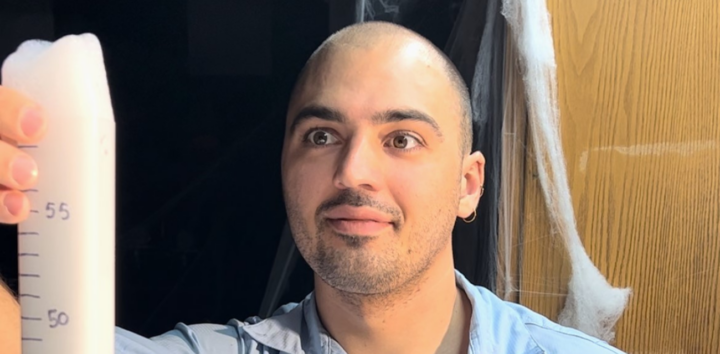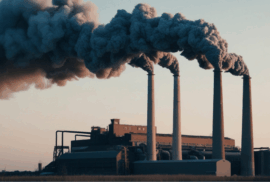Ethan Coffin: 2023 AJ Birkbeck Scholarship Winner

Authored by
Through foam, PFAS pollution solutions bubble
Ethan Coffin goes to wastewater treatment plants, dips things in its water, and studies what’s picked up. He speaks to public works engineers about water infrastructure. He reads research on foam.
It all may seem mundane work at the surface, but see Coffin in action, and you might be reminded of the wave of 19th- and 20th-century tinkerers, those everyday people who took to their sheds and kitchens and emerged with devices that would solve their problems and, eventually, many others’.
At the wastewater treatment plant, Coffin uses a homemade foam scooper and air capturer. At the lab, a contraption of his creates a small waterfall, complete with foam that bubbles up from the bed.
These small, innocuous inventions serve a big, society-changing goal of Coffin’s: to bring us “one step closer to a PFAS-free world.”
For his work, the PFAS Alliance and the Michigan Environmental Council have awarded Coffin the first-ever AJ Birkbeck Scholarship, an award given to a student at a Michigan college or university to conduct community projects around PFAS.

The folly of industry
Per- and polyfluoroalkyl substances (PFAS’s full name) come from some of those same tinkerers of old. But instead of sheds and kitchens, these people tinkered with their employers: major manufacturing corporations. They created thousands of different PFAS that could deflect water and prevent sticking. They coated them on hundreds of product types: cookware, shoes, paper, coats, upholstery. Then, these millions of goods were shipped across the United States and the world.
These companies, however, soon discovered PFAS could cause real harm to people and ecosystems. They kept it quiet for decades.
Our knowledge of PFAS’ effects is still emerging, but we do know these substances are linked to infertility and stunted development, cancer and immune deficiencies. We also know that PFAS now contaminates drinking water and soil, food packaging and personal care products. And true to their water- and stick-proof nature, these chemicals last a long time wherever they land, accumulating and accumulating, earning them the dubious nickname “forever chemicals.”
People like AJ Birkbeck—whom Coffin’s scholarship is named after—helped bring the extent of our world’s PFAS pollution to light. After local Rockford, Michigan residents discovered the neighborhood industry Wolverine Worldwide had been polluting their community with PFAS for decades, Birkbeck used his prowess as an attorney to hold the company accountable, bringing about society-wide action.
The AJ Birkbeck Scholarship awards students who embody Birkbeck’s character: someone who seeks to solve a seemingly impossible problem created by a seemingly unconquerable foe.
That was not lost on Coffin, who was formally recognized with the scholarship on what would have been Birkbeck’s 63rd birthday.
“It’s emotional,” he said. “It’s not like any other scholarship. It’s a memorial of AJ and the grassroots movement. It’s really important… the idea that you can do it. You don’t have to wait for someone else.”

Change bubbles up from foam
Coffin first learned about PFAS in a hydrology class at Miami University in Ohio, where he earned his bachelor’s and master’s degrees in geology.
It was this class, paired with longtime interests in enjoying and protecting nature, that prompted Coffin to adjust his graduate work from the study of the earth to the study of water.
Western Michigan University was a perfect fit for his hydrology doctorate. The Kalamazoo university makes the study a “key pillar” he said. A discussion with the program’s leading professor, Matt Reaves, confirmed it. Reaves studied PFAS, and Coffin quickly joined his effort once he enrolled.
Coffin began studying transformations of PFAS in landfills, where PFAS-laden products break down into the ground, but soon moved into the wastewater treatment world.
Treatment plants take in our dirty, used water; remove pollutants; and send the cleaned water back to our lakes or streams or for human reuse. But there is no widespread method for plants to remove the forever present and accumulating PFAS, perpetuating a pollution problem.
Coffin began studying the foam that Kalamazoo’s plant would create as it moved and treated wastewater. This foam is perhaps our most visual, notorious signifier of PFAS, which is otherwise unidentifiable to the naked eye.
The foam itself is not entirely made of PFAS, but the compounds accumulate in foam in high concentrations. That was in stark contrast to the millions of gallons of water the treatment plants cycled through daily, whose PFAS concentrations were far less and far more spread apart.
Foam in water, Coffin said, is a signifier that something other than water is there. Foam acts as a filter, bringing high concentrations of chemicals and substances.
He and Professor Reaves saw an opportunity. Rather than trying to capture and remove all the PFAS from the millions of gallons of wastewater that are treated daily in Kalamazoo through a tough, tedious combustion process, they could instead target the foam, the most dangerous and monstrous accumulation of the PFAS.
Creating and removing foam could rid our waters of much of their pollution.
This invoked other questions. How does this foam form? How can its dangerous contents best be removed? Enter Coffin’s work.
Coffin created contraptions that allow him to capture foam at wastewater treatment plants and study their makeup. He then created a waterfall-producing device to figure out how foam with PFAS in it is created. A third device, still under works, will help him measure the PFAS that ends up in the air at treatment plants.
Coffin said he ultimately hopes his monitoring and remediating devices will help close “critical knowledge gaps” in the ways PFAS accumulates and is used at a far larger scale. That could help engineers and governments across the world develop the best ways to track and remove PFAS in ways that potentially save thousands of lives and the wellbeing of thousands more.
Research aside, the signs for change are already promising. Michigan and the nation have begun enacting phasing PFAS-laden products out of everyday use and setting standards for certain PFAS compounds in water.
Personally, Coffin has found both an understanding of and a willingness to take part in the pollution protections by those around him. Most students in his doctoral cohort and in undergraduate courses know what PFAS is. The engineers and public works department employees he works with are ready to adjust the ways they do business.
“Over the past two years I have had the privilege of interacting with wastewater operators, engineers, regulators, and active members of the community, humbled by the immense pride they take in what they do,” he wrote in his application. “They are motivated by protecting something far more compelling[:] the health and safety of the people in their community and beyond.”
They are, in effect, like Coffin, undaunted by a mammoth problem, ready to play their part in its resolution.
After scholarship, publications and patents
Grace Hasley, eco-journalism intern for the West Michigan Environmental Action Council, checked in with Coffin after receiving his award. A lot has happened since.
Coffin used the funds to conduct 50 samples of foam at wastewater treatment plants. He and the research team found that the foam has higher concentrations of PFAS than the water it bubbled up in, but the amount of more PFAS in the foam compared to the water depended on the makeup of the foam.
From this result, Hasley reported that Coffin is now proposing to separating the compounds of the foam out to create higher concentrations of PFAS. The higher the concentration, Coffin said, the easier it is to remove.
Coffin and company submitted a manuscript of their findings and were accepted into the Journal of Hazardous Materials. What’s more, Coffin submitted intellectual property protection for the foam sampling and harvesting devices he created, the first step toward a successful patent application.
Discover
Power environmental change today.
Your gift to the Michigan Environmental Council is a powerful investment in the air we breathe, our water and the places we love.
Sign up for environmental news & stories.
"*" indicates required fields




